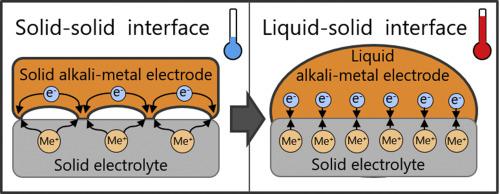Materials Today Energy ( IF 9.0 ) Pub Date : 2020-09-02 , DOI: 10.1016/j.mtener.2020.100515 D. Landmann , G. Graeber , M.V.F. Heinz , S. Haussener , C. Battaglia

|
Dendrite formation limits the cycle life of lithium and sodium metal anodes and remains a major challenge for their integration into next-generation batteries, even when replacing the liquid electrolyte by a solid electrolyte. Voids forming in solid metal anodes at the interface to a solid electrolyte on stripping cause current constrictions on plating and promote dendrite formation. Recent studies showed that alkali metal creep is the primary mechanism for replenishing the voids at room temperature. Here, we investigate plating and stripping of liquid sodium metal from a carbon-coated ceramic Na-β"-alumina electrolyte at 250 °C, thereby eliminating creep-related mass transport limitations. We demonstrate extremely high current densities of up to 2600 mA/cm2 and cumulative plating capacities of >10 Ah/cm2 at 1000 mA/cm2 without dendrite formation. Our results demonstrate that liquid metal anodes can be paired with solid electrolytes, providing a practical solution to suppress dendrite formation at high current densities.
中文翻译:

Na-β“-氧化铝陶瓷的钠电镀和剥离速度超过1000 mA / cm 2
枝晶的形成限制了锂和钠金属阳极的循环寿命,并且即使将其用固体电解质代替液体电解质,仍然是将其集成到下一代电池中的主要挑战。汽提过程中,固体金属阳极与固体电解质的界面处形成的空洞会导致电镀电流收缩,并促进枝晶形成。最近的研究表明,碱金属蠕变是在室温下补充空隙的主要机理。在这里,我们研究了在250°C下从碳包覆的陶瓷Na-β“-氧化铝电解质中镀覆和剥离液态钠金属的方法,从而消除了蠕变相关的传质限制。我们展示了高达2600 mA /的超高电流密度cm 2且累积电镀容量> 10 Ah / cm2在1000 mA / cm 2时没有形成枝晶。我们的结果表明,液态金属阳极可以与固态电解质配对,从而为抑制高电流密度下枝晶的形成提供了一种实用的解决方案。











































 京公网安备 11010802027423号
京公网安备 11010802027423号